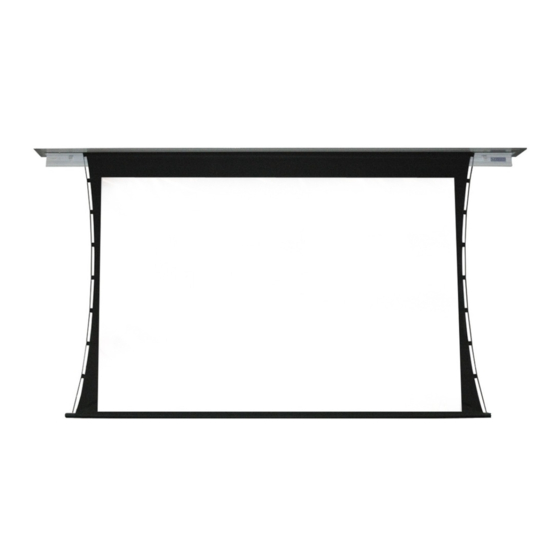Draper Ultimate Access E Istruzioni Installazione e funzionamento - Pagina 5
Sfoglia online o scarica il pdf Istruzioni Installazione e funzionamento per Schermo di proiezione Draper Ultimate Access E. Draper Ultimate Access E 7. 220v electric projection screen
Anche per Draper Ultimate Access E: Istruzioni per l'installazione e il funzionamento (7 pagine)

Ultimate Access E and V 220V
Section 6 - Operation
CAUTION: When operating for the first time, cycle unit down and up several times to confirm satisfactory operation. Be prepared to cut POWER if necessary.
•
220V SINGLE STATION CONTROL - 3-position UP-OFF-DOWN
switch permits operation to be stopped at any point. Factory
adjusted limit switches automatically stop screen when fully down
or fully up.
•
24V CONTROL - 3-button UP-STOP-DOWN switches stop at any
point desired and operate in any sequence. Factory adjusted limit
switches automatically stop screen when fully up or fully down.
Installer should incorporate an all-pole disconnect in fixed wiring
available with RF or IR remote.
Section 7 - Tab-Tension Adjustment Procedure
Please Note: Draper's
Tab-Tensioning System is
factory-set, and under normal
circumstances will not require
field adjustment. If wrinkles
are observed, however, follow
the adjustment procedure
shown in Figure 8.
Section 9 - Limit Adjustments
Figure 9
Please Note: Screen limits are
factory set. Instructions below
for minor adjustments only.
Please check with Draper prior
to resetting screen limits.
Please Note: If Screen is "Right
Hand Motor" the WHITE/DOWN
and YELLOW/UP
limit
(I)
(II)
screws are reversed
.
(Fig. 10)
Figure 10
CAUTION:
- Be sure all switches
are in "off" position
before adjusting limit
switches.
- Be prepared to shut off
manually while testing.
- Screen may be
damaged by lowering
it too far and
exposing roller.
- Motor must be
installed so that limit
switches are pointed
down.
END OF
END OF
Figure 8
DOWEL
DOWEL
PUSH & TURN
PUSH & TURN
COUNTER-CLOCKWISE
CLOCKWISE
to RELEASE TENSION
to INCREASE TENSION
DOWN Limit
DOWN Limit (I)
Clockwise
+
I
Clockwise decreases
decreases
down travel.
down travel.
UP Limit (II)
+
UP Limit
:
lI
(II)
Counterclockwise
Counterclockwise
increases up travel.
increases up travel.
Motor
Motor
End
End
e
n c
c k
d i e
B a
A u
e
d e
S i d
S i
Standard Roll
Reverse Roll
Left hand motor:
Left hand motor:
White Socket—Down
White Socket—Down
Yellow Socket—Up
Yellow Socket—Up
Right hand motor:
Right hand motor:
White Socket—Up
White Socket—Up
Yellow Socket—Down
Yellow Socket—Down
CAUTION:
DO NOT allow dowel to wrap over
roller when operating screen!
This could damage screen.
•
RS232 / ETHERNET - Serial communication and network
communication optionally available.
•
KEY OPERATED SWITCHING -
Two key-operated switches optionally available with this unit:
• Key-operated power supply switch controls power to screen and
switches. When switch is in the "off" position, screen will not operate.
Key may be removed from switch in either "on" or "off" position.
• Three-position key switch permits the screen to be operated directly
by key. Requires screen operator to have a key.
Section 8 - Electrical Connections
1. Screen operates on 220V, 50 Hz., 1.1-amp current draw.
2. Junction box is located just above the bottom access panel at the left end
of the screen.
3. Open the access panel/trap door for access to the junction box cover.
(See bottom access panel/trap door opening and closing instructions below)
4. Remove two
to expose the red, black, and white pigtail leads and the green ground
wire per wiring diagram
5. If optional low-voltage control or video interface control is specified and
factory installed, please refer to wiring diagrams
6. Screen ships with internal wiring complete and control switch
boxed. Wire to connect screen to switch
supply should be furnished by installer. Connections should be made in
accordance with attached wiring diagram, and wiring should comply with
national and local electrical codes.
7. All operating switches should be "off" before power is connected.
"Down" Limit Adjustment
:
(I)
To Reduce Screen Drop:
1. Raise screen surface approximately 1'
and turn off.
2. Turn DOWN
(I)
3. Test by lowering screen. Repeat steps 1 & 2 until desired position
is reached.
To Increase Screen Drop:
1. Lower screen to down limit.
2. With down switch on, turn DOWN
(3 screw turns = 1/2 roller revolution)
3. Test by raising screen approximately 1'
to new down limit.
4. Repeat steps 2 and 3 until desired position reached.
Motor
End
"Up" Limit Adjustment
e
n c
d i e
A u
e
If Screen Raises Too High:
S i d
1. Lower screen surface approx. 1'
and turn off.
Waterfall Roll
2. Turn UP
limit screw clockwise
(II)
Left hand motor:
3. Test by advancing screen up.
White Socket—Up
4. Repeat steps 1 through 3 until desired position is reached.
Yellow Socket—Down
Right hand motor:
If Screen Needs to Raise Higher:
White Socket—Down
Yellow Socket—Up
1. Lower screen surface approx. 1'
and turn off.
2. With UP switch on, turn UP
(3 screw turns = 1/2 roller revolution)
3. Repeat steps 1 and 2 until desired position is reached.
hex head screws that secure the cover to the junction box
(2)
.
(Page 7)
and switch
(es)
(requires 5/32" (4 mm) Hex key)
above desired setting
(30 cm)
limit screw clockwise
(3 screw turns = 1/2 roller revolution)
limit screw counterclockwise
(I)
to increase drop.
then lower
(30 cm)
below desired setting
(30 cm)
(3 screw turns = 1/2 roller revolution).
below desired setting
(30 cm)
limit screw counterclockwise
(II)
.
page 5 of 7
.
.
(Page 7)
fully
(es)
to power
(es)
.
